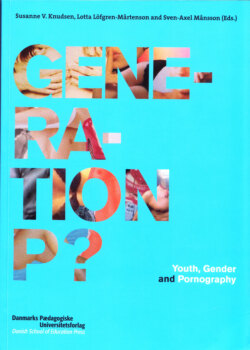Читать книгу Generation P? - Группа авторов - Страница 3
На сайте Литреса книга снята с продажи.
Introduction By Sven-Axel Månsson, Lotta Löfgren-Mårtenson and Susanne V. Knudsen
ОглавлениеPornography is a familiar phenomenon to most young people in the Nordic countries. The vast majority have seen porn and many use it actively. An internetbased questionnaire administered to Danish, Norwegian and Finno-Swedish youth in the autumn 2005 shows that 92 % of the respondents had seen porn at least once (see Kjørholt’s & Sørensen’s chapter). These results coincide with other recent research findings in the Nordic countries (Hammarén & Johansson 2002, Svedin & Priebe 2004, Häggström-Nordin et al. 2005a, 2005b, Hald 2006). The majority of the respondents of the Nordic questionnaire say that they had viewed pornography by the age of 12–14. Also, they report experiences with a wide variety of pornography, although it is the conventional hardcore genres that stand out as the most common. Compared to earlier studies on the use of pornography, for example from the mid 1990’s, these results imply an increase in young people’s experiences and use of pornography (Månsson 2000).
Hard core pornography has been freely available in the Nordic countries for a long time. In 1967, Denmark became the first nation in the world to legalise unlimited production of pornography. The other Nordic countries have followed suit and removed the general provision on pornography from the penal code. However, since pornography became freely available, it has changed considerably in its content and dissemination. There are many ways to describe this change. One is to say that the boundaries have been stretched. Many of the images that appear in mainstream media today – images depicting nakedness or explicit sexual activity and situations – would have been defined as pornography some twenty to thirty years ago. Conversely, much of what was then regarded as ‘indecent’ would most likely not be considered as such by the majority of people today. The portrayals of sex and nakedness in films and books that earned the Nordic countries – especially Sweden and Denmark – the reputation of being particularly ‘sinful’ in the 1950’s and 1960’s would hardly raise eyebrows today, certainly not in the Nordic countries itself and probably not in most other countries in the world.
Another change concerns exposure and distribution. It seems reasonable to suggest that the increasing familiarity with pornography among young people today relates to the increased visibility and accessibility of pornography in the virtual as well as in the ‘real’ world. Internet use in the Nordic countries is among the highest in the world. Thus with such a high level of ‘connectivity’ the situation in these countries may be seen as a preview of future developments in other countries (Cooper et al. 2003). Even though it is a general aspect of popular culture, the so-called mainstreaming of pornography in society has special significance for young people (see Sørensen’s chapter). TV programmes, advertising, and the music industry exploit and play with pornographic codes and scenarios. The sex industry launches and promotes its products via youth channels and websites. In other words, relationships have been forged between pornography and youth culture, which is somewhat of a new development.
